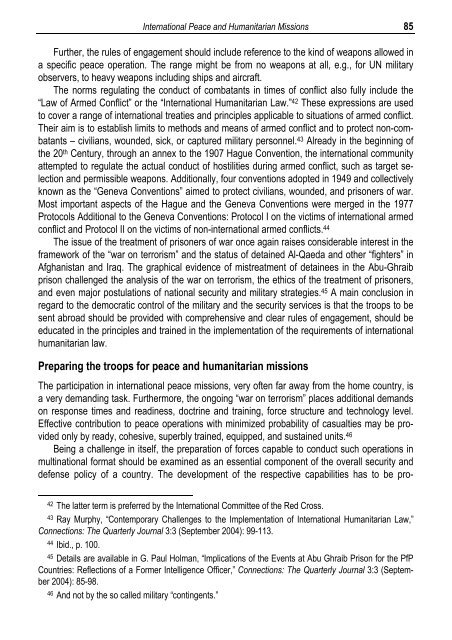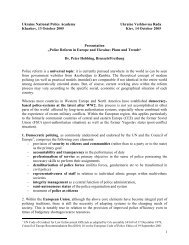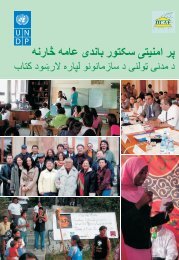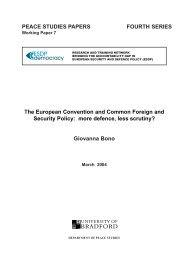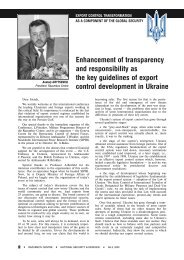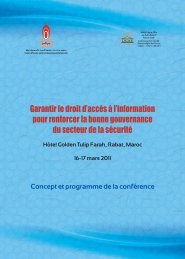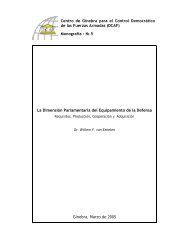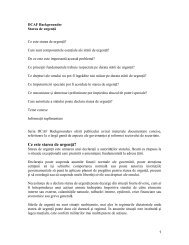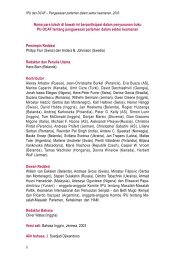Civil-Military Relations and Democratic Control of the Security Sector
Civil-Military Relations and Democratic Control of the Security Sector
Civil-Military Relations and Democratic Control of the Security Sector
Create successful ePaper yourself
Turn your PDF publications into a flip-book with our unique Google optimized e-Paper software.
International Peace <strong>and</strong> Humanitarian Missions<br />
Fur<strong>the</strong>r, <strong>the</strong> rules <strong>of</strong> engagement should include reference to <strong>the</strong> kind <strong>of</strong> weapons allowed in<br />
a specific peace operation. The range might be from no weapons at all, e.g., for UN military<br />
observers, to heavy weapons including ships <strong>and</strong> aircraft.<br />
The norms regulating <strong>the</strong> conduct <strong>of</strong> combatants in times <strong>of</strong> conflict also fully include <strong>the</strong><br />
“Law <strong>of</strong> Armed Conflict” or <strong>the</strong> “International Humanitarian Law.” 42 These expressions are used<br />
to cover a range <strong>of</strong> international treaties <strong>and</strong> principles applicable to situations <strong>of</strong> armed conflict.<br />
Their aim is to establish limits to methods <strong>and</strong> means <strong>of</strong> armed conflict <strong>and</strong> to protect non-combatants<br />
– civilians, wounded, sick, or captured military personnel. 43 Already in <strong>the</strong> beginning <strong>of</strong><br />
<strong>the</strong> 20 th Century, through an annex to <strong>the</strong> 1907 Hague Convention, <strong>the</strong> international community<br />
attempted to regulate <strong>the</strong> actual conduct <strong>of</strong> hostilities during armed conflict, such as target selection<br />
<strong>and</strong> permissible weapons. Additionally, four conventions adopted in 1949 <strong>and</strong> collectively<br />
known as <strong>the</strong> “Geneva Conventions” aimed to protect civilians, wounded, <strong>and</strong> prisoners <strong>of</strong> war.<br />
Most important aspects <strong>of</strong> <strong>the</strong> Hague <strong>and</strong> <strong>the</strong> Geneva Conventions were merged in <strong>the</strong> 1977<br />
Protocols Additional to <strong>the</strong> Geneva Conventions: Protocol I on <strong>the</strong> victims <strong>of</strong> international armed<br />
conflict <strong>and</strong> Protocol II on <strong>the</strong> victims <strong>of</strong> non-international armed conflicts. 44<br />
The issue <strong>of</strong> <strong>the</strong> treatment <strong>of</strong> prisoners <strong>of</strong> war once again raises considerable interest in <strong>the</strong><br />
framework <strong>of</strong> <strong>the</strong> “war on terrorism” <strong>and</strong> <strong>the</strong> status <strong>of</strong> detained Al-Qaeda <strong>and</strong> o<strong>the</strong>r “fighters” in<br />
Afghanistan <strong>and</strong> Iraq. The graphical evidence <strong>of</strong> mistreatment <strong>of</strong> detainees in <strong>the</strong> Abu-Ghraib<br />
prison challenged <strong>the</strong> analysis <strong>of</strong> <strong>the</strong> war on terrorism, <strong>the</strong> ethics <strong>of</strong> <strong>the</strong> treatment <strong>of</strong> prisoners,<br />
<strong>and</strong> even major postulations <strong>of</strong> national security <strong>and</strong> military strategies. 45 A main conclusion in<br />
regard to <strong>the</strong> democratic control <strong>of</strong> <strong>the</strong> military <strong>and</strong> <strong>the</strong> security services is that <strong>the</strong> troops to be<br />
sent abroad should be provided with comprehensive <strong>and</strong> clear rules <strong>of</strong> engagement, should be<br />
educated in <strong>the</strong> principles <strong>and</strong> trained in <strong>the</strong> implementation <strong>of</strong> <strong>the</strong> requirements <strong>of</strong> international<br />
humanitarian law.<br />
Preparing <strong>the</strong> troops for peace <strong>and</strong> humanitarian missions<br />
The participation in international peace missions, very <strong>of</strong>ten far away from <strong>the</strong> home country, is<br />
a very dem<strong>and</strong>ing task. Fur<strong>the</strong>rmore, <strong>the</strong> ongoing “war on terrorism” places additional dem<strong>and</strong>s<br />
on response times <strong>and</strong> readiness, doctrine <strong>and</strong> training, force structure <strong>and</strong> technology level.<br />
Effective contribution to peace operations with minimized probability <strong>of</strong> casualties may be provided<br />
only by ready, cohesive, superbly trained, equipped, <strong>and</strong> sustained units. 46<br />
Being a challenge in itself, <strong>the</strong> preparation <strong>of</strong> forces capable to conduct such operations in<br />
multinational format should be examined as an essential component <strong>of</strong> <strong>the</strong> overall security <strong>and</strong><br />
defense policy <strong>of</strong> a country. The development <strong>of</strong> <strong>the</strong> respective capabilities has to be pro-<br />
42 The latter term is preferred by <strong>the</strong> International Committee <strong>of</strong> <strong>the</strong> Red Cross.<br />
43 Ray Murphy, “Contemporary Challenges to <strong>the</strong> Implementation <strong>of</strong> International Humanitarian Law,”<br />
Connections: The Quarterly Journal 3:3 (September 2004): 99-113.<br />
44 Ibid., p. 100.<br />
45 Details are available in G. Paul Holman, “Implications <strong>of</strong> <strong>the</strong> Events at Abu Ghraib Prison for <strong>the</strong> PfP<br />
Countries: Reflections <strong>of</strong> a Former Intelligence Officer,” Connections: The Quarterly Journal 3:3 (September<br />
2004): 85-98.<br />
46 And not by <strong>the</strong> so called military “contingents.”<br />
85


